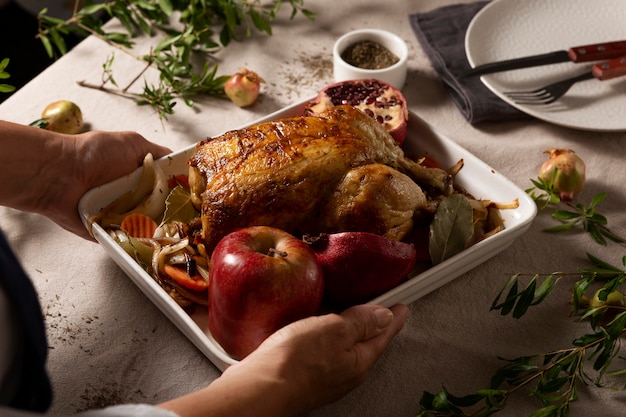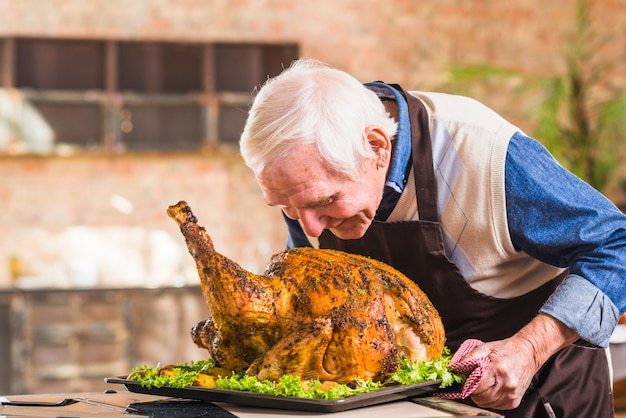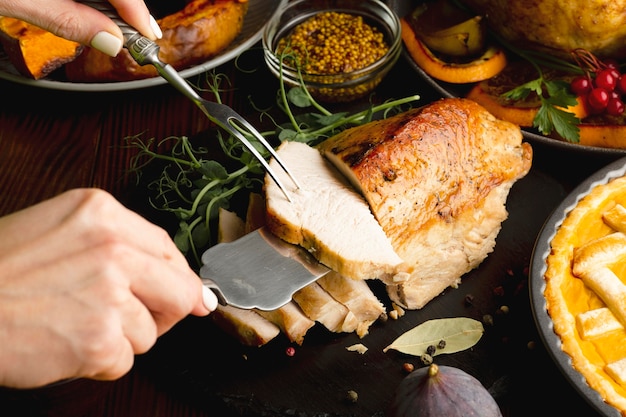Understanding the Basics

The most common question I get is: how long do I cook a turkey? It's not a simple answer like setting a timer and forgetting about it. There are a few factors that influence the cooking time, and understanding these is crucial for a successful roast.
The "Per Pound" Rule: A Starting Point
The classic rule of thumb is to cook your turkey for about 15 minutes per pound at 325°F (160°C). For example, a 12-pound turkey would need about 3 hours. However, this is just a starting point. Don't take this figure as gospel; you need to consider the type of oven you have and the desired level of doneness.
Oven Temperature: The Heat Factor
Let's be honest, not all ovens are created equal. Some ovens run hotter than others, and even newer ovens can have inconsistent heat distribution. I've learned the hard way that an older oven might need a little extra time to cook a turkey thoroughly. If you're unsure about your oven's accuracy, invest in an oven thermometer. It's a small investment that can save you from a dry, overcooked turkey.
Stuffing: A Complicating Factor
Now, if you're going down the path of stuffing your turkey, be prepared for a longer cooking time. The stuffing needs to reach a safe internal temperature of 165°F (74°C) to be safe to eat. I've always advocated for cooking the stuffing separately in a casserole dish. It's simply safer and allows for better temperature control.
(Part 2) The turkey weight Chart: Your Guide to Cooking Time

Alright, let's get down to specifics. Here's a handy chart that provides an approximate cooking time for different sized turkeys. Remember, this is just a guide, and it's always a good idea to check the internal temperature of your turkey before serving. Don't rely solely on the chart; it's just a starting point!
| Turkey Weight (lbs) | Cooking Time (hours) |
|---|---|
| 8-12 | 2.5-3.5 |
| 12-16 | 3.5-4.5 |
| 16-20 | 4.5-5.5 |
| 20-24 | 5.5-6.5 |
(Part 3) cooking tips for a perfect roast: Beyond the Basics

Now that we've covered the fundamentals, let's delve into some tips that elevate your turkey roast to a whole new level of deliciousness.
Brining: The Secret to Moisture
Brining is a game-changer when it comes to achieving a juicy, flavorful turkey. It's a simple process of soaking the turkey in a salt water solution for several hours before cooking. The salt draws moisture out of the meat, then back in, resulting in a tender and flavorful bird. There are countless brining recipes out there, but I prefer a basic combination of salt, sugar, and water. A good rule of thumb is to brine for around 12 hours, but you can adjust the time based on your preference. Just remember to rinse the turkey thoroughly before roasting.
Stuffing It Right: Safety First
If you choose to stuff your turkey, make sure you do it right after removing it from the fridge while it's still cold. Don't stuff it too tightly, and ensure you cook the stuffing until it reaches an internal temperature of 165°F (74°C). Again, I highly recommend cooking the stuffing separately in a casserole dish. It's safer and lessens the risk of foodborne illness.
Roast It Low and Slow: The Key to Tenderness
The key to a juicy, flavorful turkey is to cook it low and slow. That's why I always recommend roasting your turkey at 325°F (160°C). This allows the meat to cook evenly without drying out. For extra moisture, consider covering the turkey with foil for the first part of the cooking time. Remove the foil for the last hour to allow the skin to brown and crisp up.
(Part 4) Monitoring Your Turkey: Knowing When it's Done
So your turkey is in the oven, and you're probably wondering how to know when it's cooked through. This is where a meat thermometer becomes your best friend! It's the only way to ensure your turkey is safe to eat. Here's what you need to know:
The Internal Temperature: The Gold Standard
The turkey is fully cooked when the internal temperature reaches 165°F (74°C) in the thickest part of the thigh, without touching bone. Don't rely on just looking at the turkey; the meat thermometer is your reliable guide.
Checking the Leg: A Secondary Check
Another trick is to wiggle the leg. If it moves freely, it's likely done. However, this shouldn't be your sole indicator. Always double-check with the thermometer! It's better to be safe than sorry.
(Part 5) Resting is Key: Letting the Juices Redistribute
Okay, so your turkey is cooked, but don't rush to carve it immediately. Let it rest for about 15-20 minutes before carving. This allows the juices to redistribute throughout the meat, resulting in a much more juicy and tender bird. Cover the turkey loosely with foil while it rests. This will help retain the heat and keep the meat moist.
(Part 6) The Art of Carving: A Step-by-Step Guide
Alright, the moment of truth has arrived! It's time to carve that turkey. It can seem daunting, but it's actually quite simple.
The Steps: Making it Easy
Start by removing the legs and thighs. Then, use a sharp knife to separate the breast from the rib cage. Finally, carve the breast into slices. Make sure to use a sharp knife for a clean cut and to avoid tearing the meat.
(Part 7) Leftovers? No Problem! Putting Those Delicious Bits to Good Use
So you've enjoyed your delicious turkey dinner, and you've got a mountain of leftovers. Don't worry, leftovers are a bonus! You can use the turkey in a variety of dishes like sandwiches, salads, soups, or even a turkey pot pie. Keep leftovers refrigerated for up to 4 days, or freeze them for longer storage. Remember to heat leftovers thoroughly before eating.
(Part 8) Don't Be Afraid to Experiment: Adding Flavor with Herbs and Spices
Don't be afraid to get creative when seasoning your turkey. A simple combination of salt, pepper, and herbs like thyme, rosemary, and sage is always a classic. But feel free to experiment! Over the years, I've tried all sorts of flavor combinations. Just make sure to season the turkey generously both inside and out.
(Part 9) Serving Up a Feast: The Grand Finale
Finally, you're ready to serve your perfect roast turkey. Arrange the carved meat on a platter and surround it with your favorite sides. Don't forget the gravy! I like to make a simple gravy from the turkey drippings. Just add a bit of flour and water to the pan drippings and simmer until thickened. You can also use store-bought gravy, but homemade gravy always tastes better.
(Part 10) FAQs: Answering Your Most Pressing Questions
1. Can I cook a frozen turkey?
You can cook a frozen turkey, but it will take much longer. It's always best to thaw the turkey in the refrigerator for several days before cooking. A 12-pound turkey can take up to 3 days to thaw completely in the fridge. Thawing a turkey properly in the fridge is the safest way to ensure it's cooked evenly.
2. How do I know if my turkey is done?
As I mentioned earlier, the best way to know if your turkey is done is to use a meat thermometer. The internal temperature should reach 165°F (74°C) in the thickest part of the thigh, without touching bone. You can also check the leg. If it moves freely, it's likely done. But again, don't rely on this alone; the thermometer is your trusted guide!
3. What if my turkey is overcooked?
Overcooked turkey can be dry and tough. There's not much you can do to salvage it, unfortunately. However, you can make it more palatable by shredding it and using it in a soup or stew. Adding a bit of broth or gravy can also help to keep it moist.
4. Can I leave the turkey out on the counter to cool?
Absolutely not! It's crucial to refrigerate your cooked turkey as soon as possible. It should be placed in the fridge within two hours of being cooked. Leaving it out on the counter for too long increases the risk of foodborne illness.
5. What do I do with the turkey carcass?
Don't throw that carcass away! It's perfect for making a delicious turkey stock. It's a great way to use up all those leftover bits and bones. Simply add the carcass, some vegetables, and herbs to a large pot of water. Bring to a boil, then reduce the heat and simmer for several hours. Strain the stock, and you've got a delicious base for soup, stew, or gravy.
(Part 11) Enjoy Your Perfect Roast: A Culinary Triumph
There you have it, my complete guide to cooking the perfect roast turkey. Don't be intimidated by the process. With a little planning and preparation, you can easily create a delicious and impressive meal for your family and friends. Remember, the key is to start early, be patient, and most importantly, have fun with it! Happy cooking, and enjoy your culinary triumph!
Everyone is watching

Corn on the Cob: The Ultimate Guide to Perfectly Cooked Ears
Healthy MealsAh, corn on the cob. Just the name evokes images of sunny days, barbecues, and that sweet, juicy flavour that ...

Perfect Pork Roast Oven Cooking Time: A Guide to Delicious Results
Healthy MealsThere's something truly satisfying about a perfectly roasted pork. The aroma alone is enough to make your mout...

Ham Cooking Time: How Long to Bake, Smoke, or Boil a Delicious Ham
Healthy MealsAh, ham. It's a classic, isn't it? A real crowd-pleaser, especially around holidays. And when done right, it'...

Scallops: The Ultimate Guide to Perfect Cooking
Healthy MealsAh, scallops. Those delicate, sweet, and utterly delicious morsels of the sea. They hold a special place in my...

Spaghetti Squash: The Ultimate Guide to Cooking and Serving
Healthy MealsRemember that time you saw spaghetti squash at the supermarket, looking all bumpy and strange, and thought, "W...
